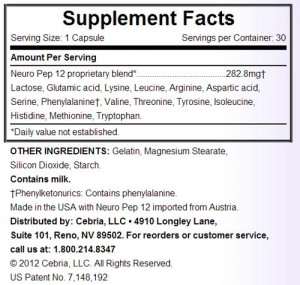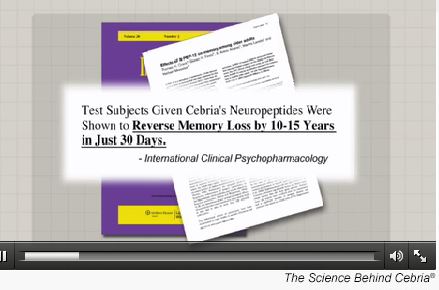Cebria Reviews: Does it Enhance Memory?
About Cebria
Cebria has been advertising since about 2012 as a natural memory enhancement supplement. The official website is cebria.com, which was registered back in 2001, although the domain was parked until 2012. By the end of 2015, Cebria could still be seen advertising online, although its television campaign appears to have ended.
How much does Cebria cost?
Unfortunately, a new user can’t simply visit the official website and order a bottle. You must go through their “free trial” in order to to obtain your first bottle of the product.
The free trial is $9.95 shipping. After 30 days from the date of purchase, you will be billed for TWO bottles at $39.95 per bottle, plus $9.95 shipping.
So Day 1 = $9.95, Day 30 = $89.95.
They also give you an ebook and a supply of “Perfect Omega” which you also must pay $7.95 for if you want it.
What they claim
- Lift the mental “fog”
- Think faster and remember more
- Increased retention of information
- 12 million doses taken worldwide
In 2012, the website claimed you could “reverse memory loss by as much as 10-15 years in just 30 days.” That tagline has since been removed from most of the website, although it appears in a video about the science behind Cebria.
Spokesmen
Cebria currently has three spokesmen: Dr. Marcus Laux, Dr. Herbert Moessler, and Dr. Eliezer Frankenberg. This blogger lists Dr. Laux on the “Encyclopedia of American Loons.”
Cebria Ingredients
 The label for Cebria is listed on the website in the “How it works” section.
The label for Cebria is listed on the website in the “How it works” section.
It is a proprietary blend of “Neuro Pep 12” which includes:
Lactose, Glutamic acid, Lysine, Leucine, Arginine, Aspartic acid, Serine, Phenylalanine, Valine, Threonine, Tyrosine, Isoleucine, Histidine, Methionine, and Tryptophan.
Many of these amino acids have been associated with cognitive health, but you’ll note that the label does not list the amount of any individual ingredient found in Cebria.
Although the label is provided, what we don’t see, however, is a link to studies which confirm positive results in taking amino acids. As I’ll show you below, you can find a study which negates some of the claims about the product.
Alternatives to Cebria
A WebMD article lists several popular supplements – that are not found in Cebria – as possible cognitive enhancers. These include ginkgo biloba, fatty acids, Vitamin E, Acetyl-L-carnitine, and ginseng.
Dr. Andrew Weil mentions mental and physical activity, social connections, ginkgo, Acetyl-L-carnitine, and phosphatidyl serine as possible ways to combat cognitive decline.
I take an amino acid supplement from GNC called Amino 1000. It contains all of the amino acids listed on the Cebria label above, plus more – 20 amino acids in all. That product costs about $22, and requires no free trial or auto-ship, not to mention that it is available locally. (I have no connection with GNC, and purposely do not link to that product so I will not appear to be profiting from it.)
My Observations
I first noticed advertising for Cebria late one night while scanning cable TV channels. An infomercial called “Losing Your Memory??” was airing. The infomercial extolled the virtues of Cebria, chock-full of customer endorsements (“I swear by it!”) and impressive graphics showing the “effect of concentrated neuropeptides.”
Cebria’s website claims that “In a double-blind study, Cebria® was shown to significantly improve short-term memory in test subjects.” The video shows the product specifically mentioned in International Clinical Psychopharmacology:
The screenshot above shows a quote which includes the product name: “Test subjects given Cebria’s neuropeptides…” A search for the word “Cebria” on the International Clinical Psychopharmacology website delivers no results. It isn’t clear where this study can be found or what it actually says, as there is no link on the Cebria website, nor any mention of Cebria where the study is supposedly located.
What I did find, however, was a 2005 double-blind study which took a look at the “Effects of N-PEP-12” on memory among older adults. Note the similarity in names between that study and Cebria’s blend, called “Nero Pep 12.” According to NYU Langone Medical Center, the 2005 study found:
“…a proprietary mixture of substances called neuropeptides have been extensively marketed for improving mental function. Radio, television, and Internet advertisements state that this product has been shown to bring about ‘a reversal of ten years of short-term memory decline.’ However, this claim is not founded in reliable evidence.”
The concerns I have about Cebria are:
- The science behind the product is not easy to find.
- A study of a virtually identical product found the claims to be “not founded in reliable science.”
- You must go through their free trial to order a bottle.
- There is an auto-ship program.
- Comprehensive amino acid blends from reputable vendors can be found at a fraction of the cost, and locally without shipping costs or delays.
As of December 2015, Cebria holds a 3 star rating on Amazon. While this is by no means a glowing endorsement, it does show that at least some customers are pleased with the product.
As with most supplements, results will be very subjective and are likely to vary based on the individual.
Bottom Line
I have taken amino acid blends which contains all of the ingredients of Cebria, and whatever effects they may have are fringe at best. If you want to try taking an amino acid blend to see if it helps your cognitive function, I suggest going to a local supplement vendor and taking a look at the options they have available. You should be able to find all of the ingredients contained in Cebria for a much lower cost.
Your Reviews
Have you tried Cebria or considered purchasing it? Give me your observations in the comments below.
Updated December 22, 2015
First published June 2014

I am using CEBRIA from the past 7 months and realized that it proved to be efficient for me.
Before taking it, I was just going to be a part of any “dumb-party”! The views, sweet memories were just like vanishing from my thoughts and often at certain times was so confused about the facts and myths. Things and thoughts were blurring from my mind before.
Thanks to CEBRIA, for helping me to get rid of my problems that I was suffering as in the type of “memory-loss”. Now I am looking forward in my future with bright aspects as I do remember the things and sweet memories for a long time.
Baloney
Enabler.